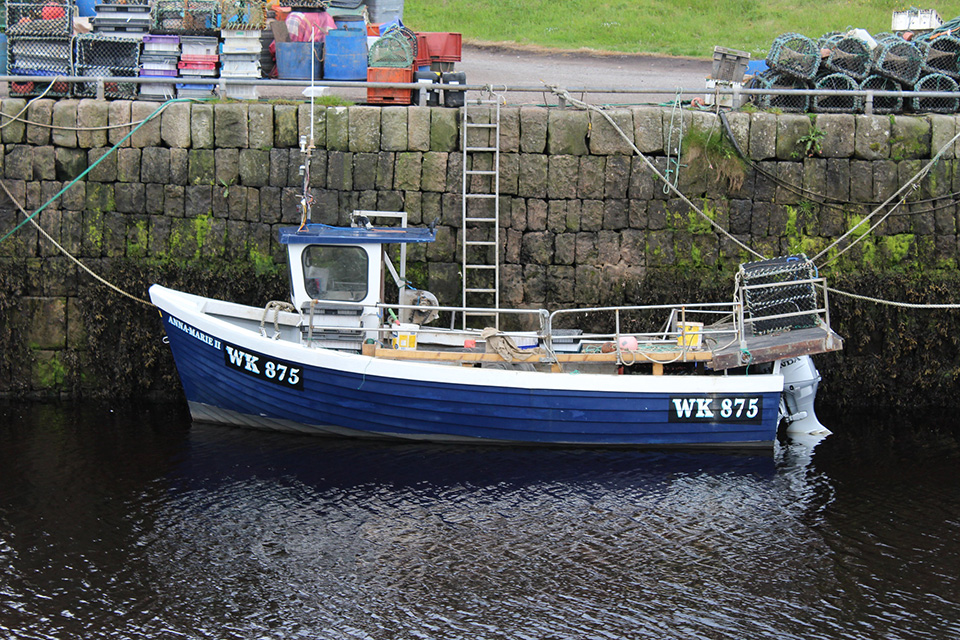Safety flyer to the fishing industry - Anna-Marie II
Published 8 July 2020
1. Summary
Capsize of fishing vessel Anna-Marie II (WK 875) with one fatality on 23 September 2019

2. Narrative
At about 1550 on 23 September 2019, the 6.2m fishing vessel, Anna-Marie II capsized as it entered the mouth of the Brora river while returning from its creel fishing grounds. The vessel broached and was slewed to starboard as the skipper lost steerage, and it was capsized and inverted due to the size and steepness of the next wave. The skipper and crewman were briefly trapped under the hull before surfacing. It is likely the skipper struck his head during the capsize, which might have affected his ability to swim. The crewman managed to swim ashore.
The alarm was raised by two passers-by at Brora harbour and a local skipper was able, after calling a “Mayday”, to head out to the scene of the capsize and he recovered Anna-Marie II’s skipper within minutes of the alarm being raised. He commenced cardiopulmonary resuscitation while helming his own vessel back into the harbour. An ambulance and coastguard rescue helicopter were on scene quickly and Anna-Marie II’s skipper was flown to hospital, where he was declared deceased. The cause of death was determined as drowning.
The MAIB investigation found that:
-
Anna-Marie II’s skipper had sailed that morning to reposition and recover two strings of creels in preparation for winter, and was returning to harbour as sea conditions had deteriorated, preventing the recovery of the last string of creels.
-
The waves at the time of the accident were very unusual for the Brora harbour entrance, and had developed very quickly to a height of approximately 3m to 3.5m and were not evident from any weather forecasts.
-
The experienced local skipper underestimated the risk of capsize in the prevailing conditions and was caught out by the unusually high waves that he encountered.
-
Anna-Marie II’s skipper and crewman were not wearing personal flotation devices (PFDs), although the skipper had reportedly worn one when working single-handed.
3. Safety Lessons
-
In open fishing vessels the risk of capsize and inverting, particularly in steep waves, is higher compared with decked vessels. Therefore, it is important that fishermen reduce the risk ofbroaching and capsize by conducting a thorough assessment to ensure they are prepared if acapsize occurs. Potential mitigation measures prior to crossing a river bar could include:
- Ensuring the boat is loaded to reduce top weight to maximise stability.
- Checking the boat and making sure hatches and equipment are adequately stowed.
- Double-checking conditions are safe from an assessment point clear of the bar and that there is a suitable alternative port of refuge.
- Carrying a portable waterproof means of communication.
-
The MCA introduced the mandatory wearing of PFDs because of the significant number of fishermen who have drowned following fishing vessel accidents. The potential benefits of wearing a PFD far outweigh the risks of secondary issues, such as entrapment. Wearing a lifejacket will help ensure that:
- You are kept afloat with your face clear of the water, allowing you to breathe, even when unconscious.
- The load on your heart is reduced as you won’t have to struggle to keep afloat and swim.
- You are easier to spot in the water and it is easier to pull you out of the water.
Our accident investigation report is available at: https://www.gov.uk/maib-reports/capsize-of-fishing-vessel-anna-marie-ii-with-the-loss-of-1-life.
Marine Accident Investigation Branch
First Floor, Spring Place
105 Commercial Road
Southampton
SO15 1GH
Email iso@maib.gov.uk
Enquiries during office hours +44 (0)23 8039 5500

